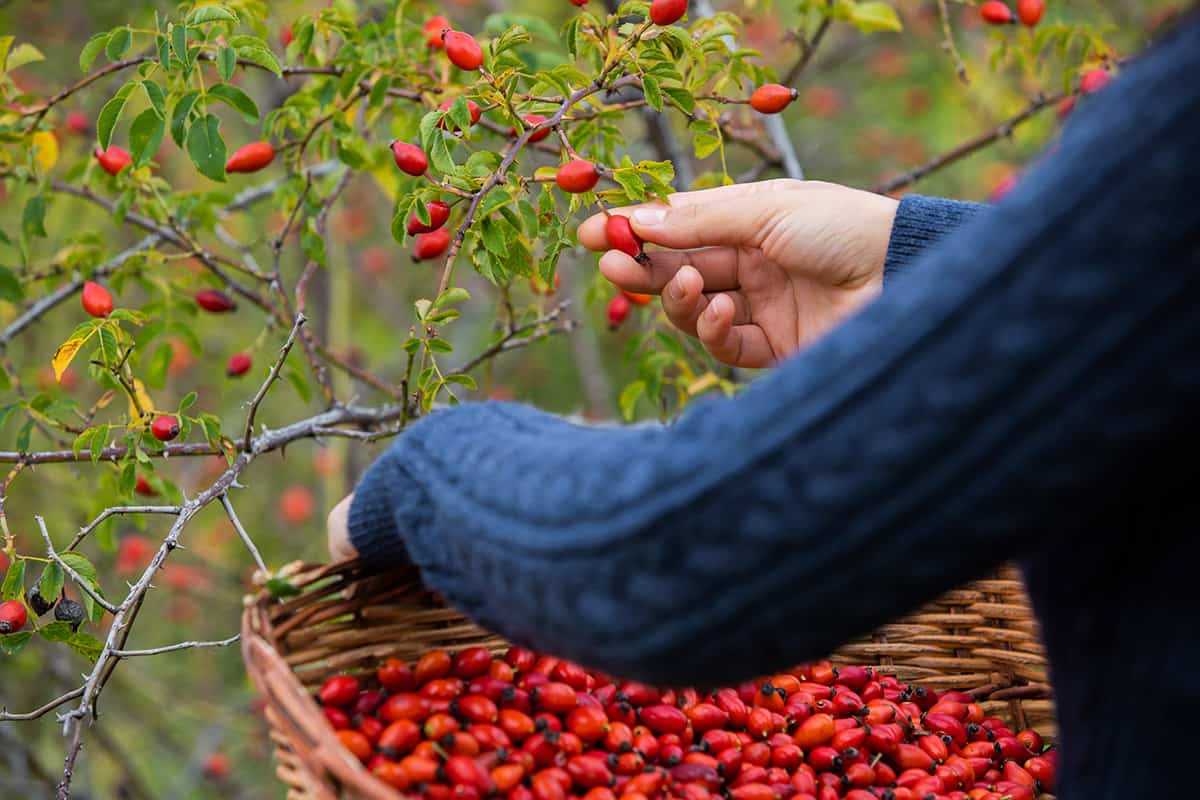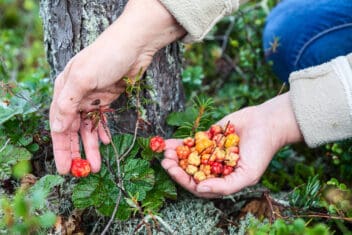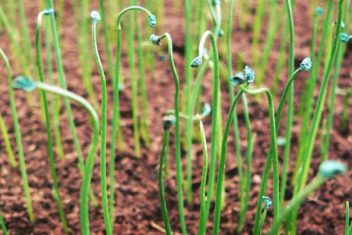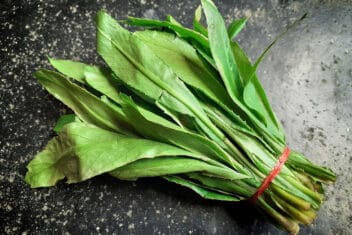You may have heard people talk about rosehips before without actually knowing what they are, let alone how to use them. And that’s absolutely okay.
There are a bajillion different plants out there, and it takes time to cultivate relationships with them.
Using rosehips after your rose flowers have wilted and fallen is a great way to honor the plant’s entire life cycle and take full advantage of all the goodness they have to offer.
Rosehips are delicious, good for your skin, and make a terrific jam.
What are Rosehips?
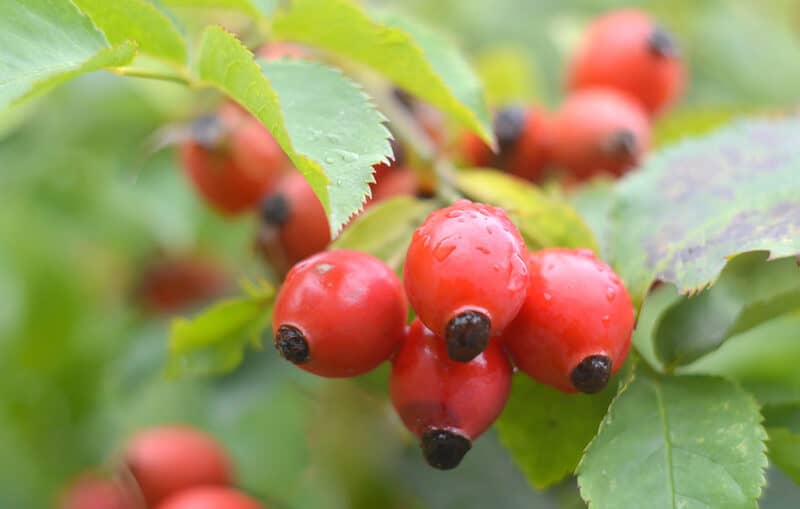
Rosehips are the fruits from various rose species (Rosa spp.). Although they might vary in size, color, and flavor, they’re all edible. Many people haven’t even noticed that roses even produce fruits, as they deadhead their roses as soon as the flowers have faded and wilted.
If you leave these flower heads on the plant, however, you’ll be gifted with an abundance of juicy red or orange fruits at the end of the season.
The ones I harvest here in Quebec are from wild dogroses (Rosa canina), and cultivated Japanese roses (Rosa rugosa sp.).
If you want to grow specifically for hips, species roses tend to produce the best ones. Species roses are the ones that are closer to natural or wild than the big, showy specimens that have been cultivated for the garden.
Why are Rosehips Beneficial?
All rosehips have beneficial dietary and medicinal properties. Both rosehip seed oil and rosehip infusions can benefit the skin because of their anti-inflammatory components.
Furthermore, rosehip seed oil has been proven to promote wound healing and improve the appearance of fine lines and scars. [1]
You can also use rosehip tea as a mouthwash to alleviate pain and inflammation from canker sores. Furthermore, a strong rosehip infusion swished around your mouth a few times a day will help to speed healing from dental surgery or cuts/injuries to the gums, tongue, and roof of the mouth.
When taken internally as a tea, tincture, or even in foods, rosehips have several beneficial health effects. For one, their high vitamin C content helps the body to produce collagen and white blood cells.
Rosehips are natural antioxidants, so they help to slow the aging process. In addition to their high C levels, rosehips also offer decent amounts of vitamins B3, D, E, beta carotene, and zinc.

Additionally, rosehips offer significant cardiovascular health support. According to this Swedish study:
“Daily consumption of 40 g of rosehip powder for 6 weeks can significantly reduce cardiovascular risk in obese people through lowering of systolic blood pressure and plasma cholesterol levels.” [2]
How’s that for a great list of benefits? If you didn’t already grow roses for their scent and beauty, definitely start growing them for their beneficial health effects!
Don’t forget how tasty they are. You’ll most often see rosehips made into a jam, but they are more versatile than that. They can be dried, turned into syrup, or cooked up into soup.
When and How to Harvest Rosehips
Rosehips generally appear between late summer and late autumn, depending on where you’re located. Try to gather rosehips after the first frost.
This is because freezing temperatures break down the fruits’ cellular walls. When this process happens, the hips get sweeter and juicier, and you’ll be able to extract more of their deliciousness.
If you live in a place that only gets mild winters, pick the hips when they look full, ripe, and healthy. Pop them into the freezer for 24-48 hours, and then use them in culinary and/or medicinal recipes.
You can keep rosehips frozen for up to six months to use as needed. Be sure to label them clearly with the date that you stored them, so they don’t end up languishing at the back of the freezer, unused.
Here’s a tip I learned the hard way: freeze them in ice cube trays or well spaced out on baking trays. THEN transfer them into freezer bags or freezer-safe plastic containers.
I made the mistake of popping a batch into Ziplock bags when fresh and ended up with a bizarre, unidentifiable orange-purple mush that I had to taste to figure out what it was.
*Note: Only harvest rosehips from plants that haven’t been sprayed by pesticides. The last thing you want (or need) is to contaminate your rosehips with poisons.
Harvesting rosehips from really wild spaces should be okay. Similarly, if you grow your own plants, or you have close friends or family members who grow them without pesticides, those should be safe as well.
Processing and Storage
As mentioned, the best way to store rosehips is by freezing them. This retains all their medicinal properties and also preserves their flavor. Rosehips don’t taste like roses, but instead have a bright-yet-earthy taste, somewhere between flowers and citrus.
Of course, freezing all these hips also takes up a fair bit of valuable real estate in the freezer. If you need this space for produce or protein, then another option is to dry the rosehips instead.
Although these can be dried whole, they dry more quickly and thoroughly if you halve them. Additionally, cutting them in half means that you can see whether they’ve dried out completely or not.
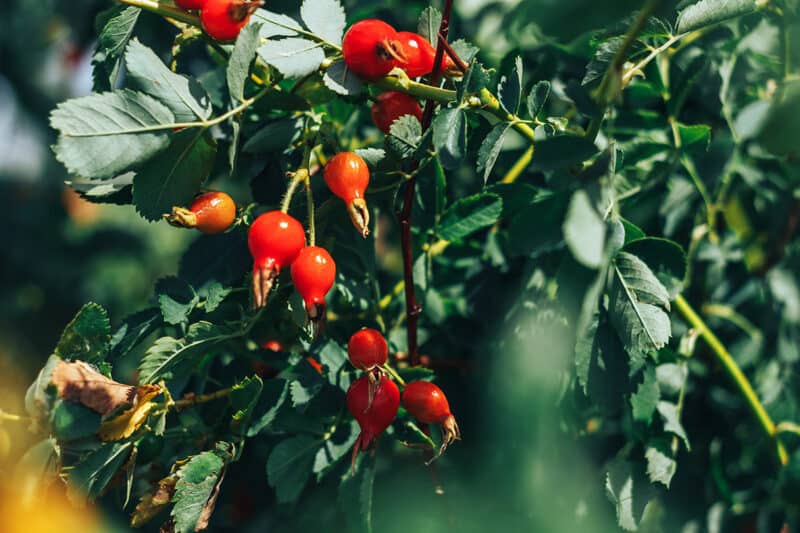
Remember that one moldy rosehip can spoil an entire batch that it’s stored with. It’s generally better to err on the side of caution than to risk contaminating and ruining invaluable herbal allies.
To dry the hips in the sunshine, cut them in half and spread them out on paper or a dry towel in the sun. They’ll need to be out there for several hours, and you’ll likely have to repeat this process a few days in a row to make sure they’re fully dried.
A better way is to use a food dehydrator. Either halve the hips or slice them thinly and spread them out over the racks. Set the dehydrator to about 110°F, and leave them in there until they’re bone dry. Time for this can vary, depending on your dehydrator, but it usually takes several hours.
Once they’re dry, transfer them into a clean glass jar with a lid. Store this in a cupboard, out of direct sunlight, and use it as needed.
Let’s take a look at a few different ways you can start using rosehips.
Rosehip Tea
Rosehip tea is delicious and nutritious!
As mentioned, these glorious fruits are ridiculously high in vitamin C. They’re pretty much invaluable for helping to boost your immune system, especially in wintertime. Hey, who knew roses could help prevent scurvy?!
Rosehip tea has been used to fight colds and the flu pretty much forever. To make tea with them, steep 1 to 3 teaspoons of fresh, chopped rosehips in boiling water for 10 to 15 minutes. Drink it as hot as you can, with either honey or maple syrup if you want to cut the sourness.
This tea is also good for easing a fever if you serve it cold.
Antioxidant Tea Blend for Heart Support
Renowned herbalist Rosemary Gladstar touts this berry-rich nutritive tonic for overall heart health. It’s gentle enough to use on a daily basis and supports cardiovascular wellness.
This recipe is from her beginner’s guide to medicinal herbs:
- 2 parts dried elderberry
- 2 parts dried rosehips
- 1 part dried blueberries
- 1 part dried hawthorn berries
Combine all of these into a large jar, and use 1 tablespoon per cup of boiling water to make tea. Steep for 5-10 minutes, and add honey or lemon to taste, if desired. Drink one cup a day for cardio system support.
Rosehip Syrup
If you have a lot of hips to use up, consider transforming them into syrup. You’ll need:
- 1 cup strong-brewed rosehip tea
- 1/2 cup honey
Heat the tea in a saucepan on medium heat, and stir in the honey. Keep stirring until the honey is completely dissolved.
You can add a spoonful of this syrup to any other beverage to add some floral, vitamin C-rich deliciousness to it. Alternatively, you can trick kids into taking it by drizzling it over ice cream or stirring it into yogurt.
Rosehip Jam
Since rosehips have both anti-inflammatory and diuretic effects, they can be really beneficial for things like kidney or urinary tract infections. On top of that, it just tastes plain good.
Keep a jar of this delicious rosehip jam on hand for when the kids have UTIs. Offering them a bit of jam and toast on bread is a lot easier than trying to get them to take tinctures or capsules.
You’ll need:
- 1 cup de-seeded, dried rosehips, chopped
- 1 1/2 cups cherry, apple, mixed berry, pomegranate, or strawberry juice
- 1/2 teaspoon lemon juice
Pour the juice into a medium saucepan, and heat to a boil on medium-high heat. Add the rosehips, turn down the heat to low, and let this mixture simmer for 5-8 minutes.
Then, remove from the heat and cover with a lid. Let this sit overnight, either on the counter or in your refrigerator. Then add the lemon juice, and either put it through a blender or use an immersion blender to puree it until it’s smooth.
It’ll still be a bit lumpy, but that’s okay. Rosehips contain enough pectin that they should thicken this mixture nicely without having to add extra.
Transfer it to a clean, sterilized jar with a lid. You can keep this in the fridge for up to a month, or can it in a water bath for long-term storage. If you do the latter, process your jars for 10-15 minutes.
Roses really are amazing plants, and offer us far more than just their aesthetics and scent.
Now that you’ve gotten to know more about the benefits of using rosehips, you may want to hold off on deadheading those blooms come late summer. Harvest the fruits, revel in their gorgeousness and don’t forget to share them with others.
Further Reading:
Gladstar, Rosemary; Rosemary Gladstar’s Medicinal Herbs: A Beginner’s Guide. Storey Publishing (North Adams, MA, 2012)
Brill, Steve; Identifying and Harvesting Edible and Medicinal Plants in Wild (and Not So Wild) Places. William Morrow Books (New York, NY, 1994)
De La Foret, Rosalee; Alchemy of Herbs. Hay House Publishing (Carlsbad, California, 2017)
References:
- Z. Lei, Z. Cao, Z. Yang, M. Ao, W. Jin, L. Yu, Rosehip Oil Promotes Excisional Wound Healing by Accelerating the Phenotypic Transition of Macrophages, Planta Medica, May 2019
- U. Andersson, K. Berger, A. Högberg, M. Landin-Olsson, C. Holm, Effects of rose hip intake on risk markers of type 2 diabetes and cardiovascular disease: a randomized, double-blind, cross-over investigation in obese persons, European Journal of Clinical Nutrition, May 2012
